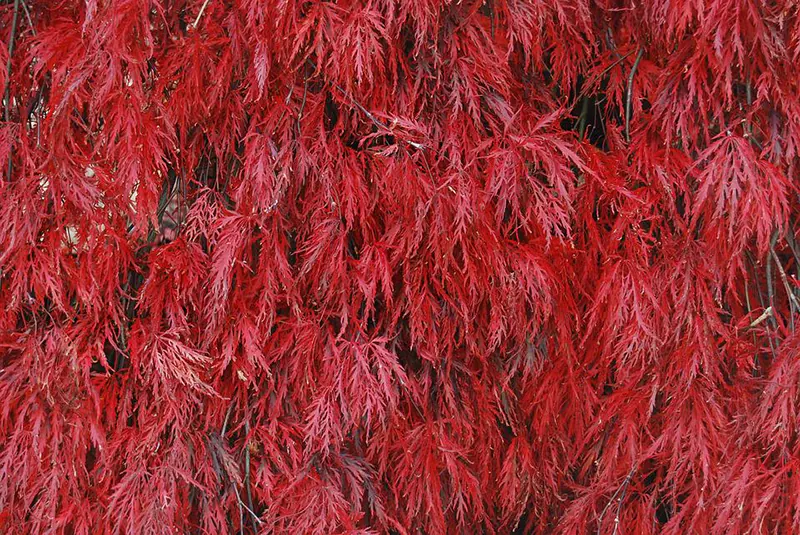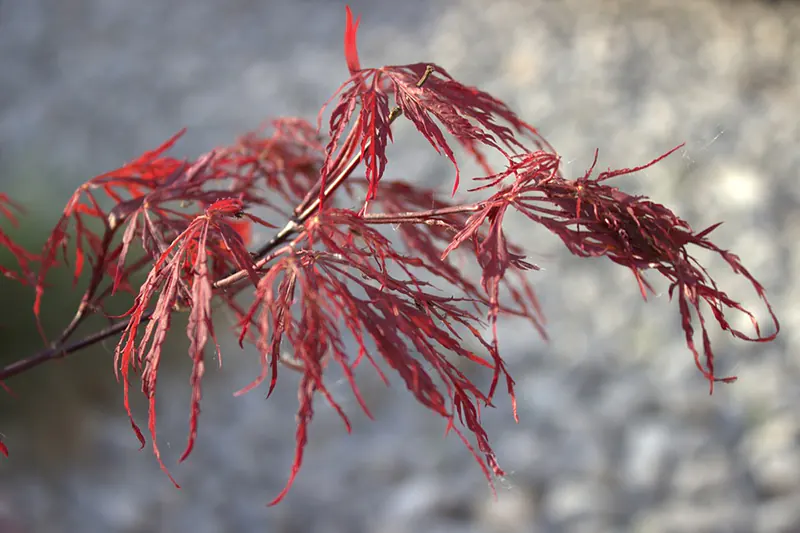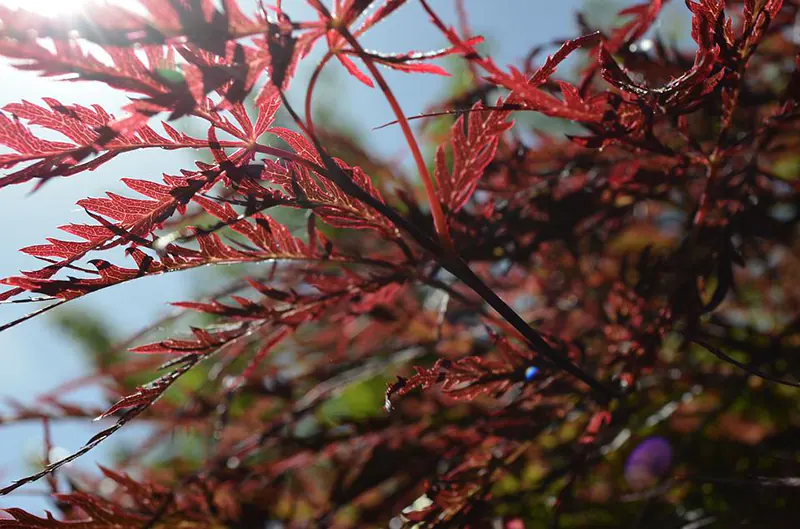Tamuke-yama Japanese Maple | Bonsai Care Guide
Acer palmatum var. dissectum
The Tamuke-Yama Japanese maple is a beautiful tree with deep red leaves. The tree grows a lace-like leaf, an illusion best seen from a distance. This beauty makes the tree a popular choice for any bonsai grower, whether new or experienced.
We’ll explain all your Tamuke-Yama growing requirements throughout this care sheet, from soil to fertilizer and everything in between. You’ll keep this tree in its gorgeous red shade through most of the year with a careful watch.
Here's what you'll find while reading our Tamuke-Yama Japanese Maple bonsai guide:
Here's what you'll find while reading our Tamuke-Yama Japanese Maple bonsai guide:
01
02
03
04
05
Quick Tamuke-Yama Japanese Maple Bonsai Care Sheet
Here’s a quick rundown of what you’ll see throughout the article, and a great mini-guide to reference while growing your Tamuke-Yama Japanese maple.
Recommended soil | Well draining akadama mix with small stones such as pumice. |
Watering | At least once a day, but may require more during warmer seasons. |
Potting season | Due to quick root growth, repot the tree every second year. |
Shaping and pruning season | Only prune larger branches during autumn. Twigs and shoots are prunable all through the year. |
Light | Plenty of light, but requires shade during warmer weather. |
Fertilizing | For optimal strength, use a combination of liquid and solid options. Otherwise, only use a solid organic fertilizer. |
Propagation methods | Through the year, seeds and cuttings are viable options. Air layering works only during summer. |
Pests and diseases | Aphids and the lethal verticillium wilt. |

How to Care for a Tamuke-Yama Japanese Maple Bonsai
Following these next sections will help you grow a healthy Tamuke-Yama Japanese maple bonsai. Here you’ll learn how frequently to water the tree, what soil to use, how to report it, and the best location to keep the plant as it grows.
Best Soil
Any regular and well-draining bonsai soil mixture will keep your tree alive and healthy. However, if you want to use the best option for the bonsai, you’ll need an akadama mix. When mixed with pumice and lava rocks, this soil type is the best option for the tree as it helps retain moisture and nutrients.
The pumice and lava rocks in this soil mixture will keep moisture around longer, lessening the frequency of your watering needs. This aspect is ideal as the Japanese maple can require watering more than once a day.
Watering
Frequently watering your Tamuke-Yama Japanese maple is an essential task each day. This bonsai tree often requires daily watering to stay healthy. However, at times you may need to water the tree more than once per day. We recommend you water the tree in the morning and check the soil’s moisture in the late afternoon.
Using soil with pumice and lava rocks mixed in will help retain moisture. This option will lessen the frequency you need to water the tree without harming its health.
Repotting
The Tamuke-Yama Japanese maple bonsai’s roots quickly grow and can prove a nuisance to cut. However, you’ll need to trim the tree’s roots at least every two years and report the plant to ensure it stays healthy and grows without interruption.
If left to grow without repotting, your bonsai will begin having issues. Use a long, thin object such as a pencil to gently part the roots for easy trimming.
Shaping and Pruning
Most of the tree is prunable throughout the whole year. You can cut the twigs, shoots, and leaves regardless of the season. However, pruning should be done sparingly so as not to damage or stress the tree’s health.
Larger branches require a cut paste to prevent infection. Additionally, these should only be trimmed when in the autumn season.
Location and Sunlight
Place your Tamuke-Yama Japanese Maple tree in a well-lit area with plenty of sunlight. Additionally, the location should be well-aired. This placement is best suited, allowing the tree to grow and thrive with enough nutrients.
However, when temperatures climb high during the summer, you’ll want to move the tree out of direct sunlight. The afternoon sun is especially dangerous for many bonsai during the summer season.
Fertilizing
When considering which fertilizer to use, you should search for a solid organic option. This selection will slowly release the nutrients, ensuring everything is absorbed into the tree without wastage. This fertilizer must be low in nitrogen to avoid large leaves and internodes.
If you’d like a stronger fertilizer, mix in a liquid option once a week while watering the tree. Do this only if the bonsai is healthy and growing well already.
Propagation Methods
You can propagate a new Tamuke-Yama Japanese maple tree through various methods. Using seeds or cuttings will quickly begin growing a new tree during any season of the year. However, if you want to air layer your bonsai, you should only attempt the method during summer for optimal results.
Pests and Diseases
The most common disease you’ll encounter while growing your Tamuke-Yama Japanese maple bonsai is verticillium wilt. This fungal infection is lethal and can kill plants if the infected area isn’t trimmed away immediately. The most terrifying aspect of this disease is its ability to spread to surrounding plants.
Among pests, the most common to attack your Japanese maple is aphids. Fortunately, these tiny sapsuckers are easily deterred. Mist your tree regularly and if you see any aphids, use a regular insecticide to deter and kill off any pests on the bonsai.
Considerations for Growing an Indoor Tamuke-Yama Japanese Maple
While it grows extremely well outdoors, the Tamuke-Yama Japanese maple tree is easily grown indoors. However, you need to consider its placement when growing it inside as it requires plenty of sunlight and water.
Placement
This tree requires a well-aired environment with plenty of sunlight, making a windowed area its best location. Being near any window that receives morning sunlight is best, as the tree will be protected from the afternoon sun while receiving plenty of light each day. Having the window open during summer and closed during winter is advised as the tree is only partially resistant to the cold.
Watering frequency
While placement is important, you’ll want the tree in an easily accessible location. Japanese maples as a species are notorious for their thirst. You’ll want to place the tree where you can quickly water it multiple times a day. We also advise keeping a bottle for misting nearby to deter pests and keep the tree healthy.
Considerations for Growing an Indoor Tamuke-Yama Japanese Maple
While it grows extremely well outdoors, the Tamuke-Yama Japanese maple tree is easily grown indoors. However, you need to consider its placement when growing it inside as it requires plenty of sunlight and water.
Placement
This tree requires a well-aired environment with plenty of sunlight, making a windowed area its best location. Being near any window that receives morning sunlight is best, as the tree will be protected from the afternoon sun while receiving plenty of light each day. Having the window open during summer and closed during winter is advised as the tree is only partially resistant to the cold.
Watering frequency
While placement is important, you’ll want the tree in an easily accessible location. Japanese maples as a species are notorious for their thirst. You’ll want to place the tree where you can quickly water it multiple times a day. We also advise keeping a bottle for misting nearby to deter pests and keep the tree healthy.
FAQs about Tamuke-Yama Japanese Maple Bonsai
Here are four of the most frequently asked questions when trying to grow a Tamuke-Yama Japanese maple bonsai. We explain the best trees of the species to start cultivating, growth rate, and size issues related to the Tamuke-Yama.
The Tamuke-Yama Japanese maple is an easy tree to keep small. The bonsai does well in containers and generally grows slower when placed in one. However, be sure to prune and shape to keep the tree at an ideal size.
The Tamuke-Yama and other Japanese maple bonsai are easy to grow indoors. There are, however, a few considerations, such as watering frequency and placement. Keep the tree’s needs met, and it’ll grow healthy, whether indoors or outdoors.
The Tamuke-Yama Japanese maple tree can grow 1-2 feet per year. However, the bonsai will grow less per year, making it easy to manage. The tree will gradually gain height with proper pruning while maintaining vibrant foliage.
There are many Japanese maple species to consider when growing one as a bonsai. One of the best of these species is the Beni Hime. The Beni Hime Japanese maple is easy to grow, suffers minimal scarring from grafting, and is a dwarf maple that never grows very large.







